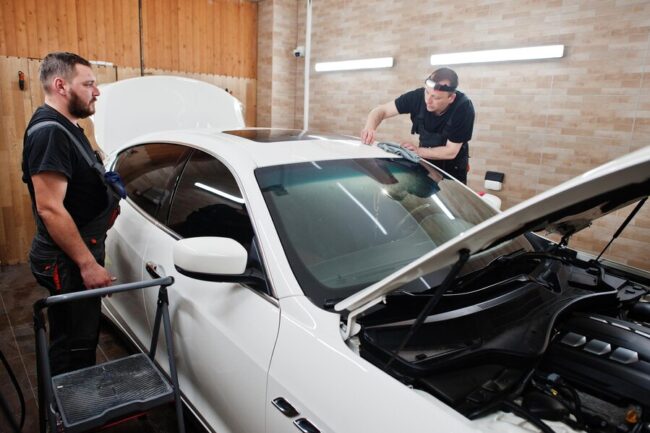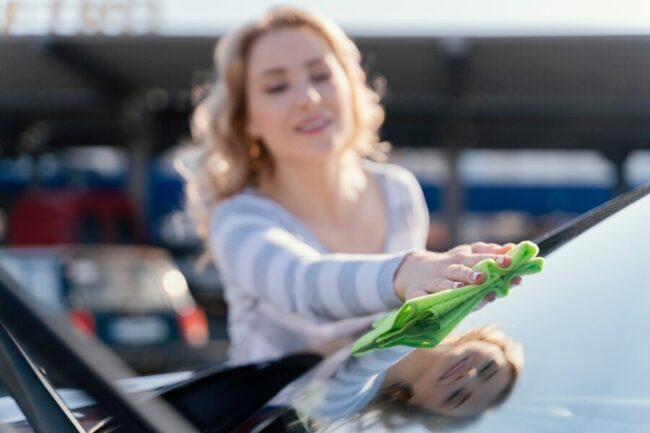Automotive window tinting has become increasingly popular for enhancing the aesthetics of vehicles and its functional benefits. One crucial aspect of window tinting is its ability to block the sun’s harmful ultraviolet (UV) rays. Understanding UV transmission rates in automotive window tinting is essential for both car owners and tinting professionals.
In this blog post, we will delve into the significance of UV transmission rates, how they are measured, and why they matter in choosing the right window tint for your vehicle. By the end of this article, you’ll understand how UV transmission rates impact your car’s protection and driving experience.
What Are UV Transmission Rates?
UV transmission rates (UVR) in automotive window tinting refer to the amount of ultraviolet (UV) radiation that can pass through the tinted windows of a vehicle. This measurement is crucial as it determines the level of UV protection provided by the window tint. A lower UVR indicates higher UV protection, as less UV radiation can penetrate the tinted windows.
This is important for reducing the risk of skin damage, premature aging, and other health issues caused by UV rays and protecting the vehicle’s interior from fading and deterioration. Understanding UVR is essential for choosing the right window tint that offers optimal UV protection for the vehicle’s occupants and its interior components.
Understanding UV Transmission Rates In Automotive Window Tinting
Understanding UV transmission rates in automotive window tinting is crucial for several reasons. UV rays from the sun can cause significant harm, not only to the skin but also to the interior of vehicles. Prolonged exposure to UV radiation can lead to skin damage, premature aging, and an increased risk of skin cancer.
Additionally, UV rays can cause fading and deterioration of the interior components of a vehicle, such as upholstery, dashboard, and electronics. By choosing window tint films with low UV transmission rates, drivers and passengers can protect themselves from harmful UV rays, maintain the integrity of their vehicle’s interior, and enhance their overall driving experience.
Factors Affecting UV Transmission Rates
Factors affecting UV transmission rates in automotive window tinting include:
- The thickness and composition of the window tint film.
- The quality of the adhesive used in the installation process.
- The type and design of the vehicle’s windows.
Thicker films with higher-quality UV-blocking materials tend to have lower transmission rates, offering better protection against harmful UV rays.
The adhesive used during installation also plays a crucial role in maintaining the integrity of the tint film over time, impacting its UV-blocking capabilities. Additionally, the design and material composition of the vehicle’s windows can influence how effectively the window tint reduces UV transmission, as certain types of glass may naturally provide some level of UV protection.
- Film Thickness: Thicker films generally offer better UV protection due to their increased ability to block UV rays.
- Film Composition: Different materials and compositions can affect UV transmission rates. For example, ceramic films are known for their high UV-blocking capabilities.
- Adhesive Quality: The quality of the adhesive used in window tint installation can impact UV transmission rates. High-quality adhesives ensure a tight bond between the film and the window, reducing UV penetration.
- Window Type: The vehicle’s window type, such as curved or flat, can influence UV transmission rates. Curved windows may require special attention during installation to maintain proper UV protection.
- Tint Color: The color of the tint can affect its UV-blocking properties. Darker tints offer better UV protection, which can vary depending on the specific tint material.
- UV Protection Ratings: Look for window tint films with high UV protection ratings, indicating their ability to block UV rays effectively. Manufacturers typically provide UV protection ratings and can help you choose the right tint.
 Thickness And Composition Of The Window Tint Film
Thickness And Composition Of The Window Tint Film
The thickness and composition of window tint film are critical factors in determining its UV transmission rates. Thicker films generally offer better UV-blocking capabilities, as they can absorb or reflect more UV rays.
High-quality films are designed with advanced materials that minimize UV transmission while maintaining optical clarity and durability. When choosing a window tint for UV protection, consider the thickness and composition for optimal performance.
Quality Of The Adhesive Used In The Installation Process
The adhesive quality in automotive window tinting installation is crucial for the film’s effectiveness and longevity. High-quality adhesives ensure strong bonding and resist environmental factors like heat, humidity, and UV exposure. Premium adhesives also contribute to a smooth installation, creating a professional finish that enhances aesthetics and functionality.
The Type And Design Of The Vehicle’s Windows.
- Window Type: Different types of windows, such as front windshield, side windows, and rear windows, have varying shapes and sizes, affecting how UV rays penetrate the vehicle.
- Curvature: The curvature of windows can impact the distribution of UV rays, with flatter windows allowing for more direct exposure and curved windows dispersing the rays.
- Glass Thickness: Thicker glass windows naturally offer more UV protection than thinner ones, although additional tinting can further enhance this protection.
- Tinting Compatibility: The design of the vehicle’s windows can influence the effectiveness of window tinting films, with some designs allowing for a more accessible and uniform application of tint films.
- Seals and Gaskets: Well-maintained seals and gaskets around windows can help prevent UV rays from seeping into the vehicle, complementing the UV protection provided by window tinting.
- Ventilation Options: Windows that can be partially opened or equipped with ventilation features can impact UV exposure inside the vehicle, as well as the effectiveness of tinting in those areas.
Benefits of Low UV Transmission Rates
Low UV transmission rates in automotive window tinting significantly benefit both the vehicle and its occupants. By reducing the amount of UV radiation entering the car, these tint films provide essential protection against harmful UV rays. This protection helps prevent skin damage and premature aging caused by UV exposure, ensuring a safer and more comfortable driving experience.
Low UV transmission rates can also help preserve the vehicle’s interior by minimizing fading and deterioration of upholstery, dashboard, and other surfaces. This preservation not only maintains the aesthetic appeal of the car but also extends the lifespan of its interior components, enhancing its overall value.
- Skin Protection: Shields occupants from harmful UV rays, reducing the risk of skin damage, sunburns, and skin cancer.
- Interior Preservation: Minimizes fading and deterioration of car interiors, including upholstery, dashboard, and trim, preserving their appearance and value.
- Comfortable Driving Experience: Reduces glare and heat buildup inside the car, enhancing comfort for both the driver and passengers.
- UV-sensitive Materials Protection: Helps protect sensitive materials in the car, such as electronics, from UV-related damage and deterioration.
- Health Benefits: Contributes to overall health and well-being by reducing UV exposure during daily commutes or long drives.
- Long-term Cost Savings: Helps prevent the need for premature replacement or repair of interior components, saving money in the long run.
These benefits highlight the importance of choosing window tint films with low UV transmission rates for personal safety and vehicle maintenance.
 Regulations And Standards For UV Protection
Regulations And Standards For UV Protection
Regulations and standards for UV protection in automotive window tinting vary depending on the region and country. In the United States, for example, each state has regulations regarding the allowable darkness of window tint and the percentage of visible light transmission (VLT) that must be maintained. These regulations often aim to ensure that window tints do not impair the driver’s visibility or pose a safety hazard on the road.
Additionally, industry standards and certifications, such as those from the International Window Film Association (IWFA), provide guidelines for manufacturers and installers to follow regarding the UV-blocking capabilities of window tint films. These standards help consumers make informed choices about the level of UV protection they can expect from different window tint products.
- Regional Variations: Laws and guidelines vary by region.
- Visible Light Transmission (VLT): VLT percentage determines tint darkness and UV protection.
- UV Protection Standards: Some regions have specific standards for UV-blocking capabilities.
- Legal Limits: Maximum VLT percentages are specified for different windows.
- Exemptions and Special Cases: Some vehicles have different tinting requirements.
- Enforcement and Penalties: Regulations are enforced with fines or citations.
Choosing The Right Window Tint For UV Protection
Choosing the right window tint for UV protection is crucial to safeguard yourself and your vehicle from harmful UV rays. For maximum protection, look for films with low UV transmission rates (UVR), ideally below 1%. Consider the tint’s quality, composition, and certifications to ensure effectiveness. Proper installation is vital to maintain its efficacy. Prioritizing UV protection in your window tinting choice ensures safer rides and preserves your vehicle’s interior.
Comparison Of Different Types Of Window Tint Materials And Their UV-Blocking Capabilities
When comparing window tint materials for their UV-blocking capabilities, it’s crucial to consider their composition and construction. High-quality films, like ceramic, are known for superior UV protection due to ceramic particles that block a high percentage of UV rays while allowing visible light transmission.
Carbon films balance UV protection, heat rejection, and durability, making them popular. However, adequate for heat rejection, metallic films may block UV rays less effectively. Understanding these differences helps consumers choose based on their specific UV protection needs and other performance factors.
Tips For Ensuring Proper Installation To Maximize UV Protection Benefits
- Choose a reputable installer with experience in automotive window tinting.
- Ensure the film is applied evenly, without wrinkles or air bubbles.
- Thoroughly clean and dry the windows before installation.
- Select high-quality window tint films with proven UV-blocking capabilities.
- Follow the manufacturer’s instructions for installation.
- Regularly maintain the tint by cleaning with mild soap and water and avoiding abrasive materials.
Conclusion
Understanding UV transmission rates is crucial when choosing the right window tint for your vehicle. By selecting a tint with low UV transmission rates (UVR), you can significantly reduce the amount of harmful UV rays entering your car. This protects you and your passengers from potential health risks associated with UV exposure and helps preserve the interior of your vehicle by minimizing fading and deterioration.
When considering window tint options, be sure to look for films that are specifically designed to block UV rays effectively. Additionally, ensure that professionals install to maximize the UV protection benefits. By prioritizing UV protection in your window tinting choices, you can enjoy a safer and more comfortable driving experience while safeguarding your vehicle’s interior against UV-related damage.




